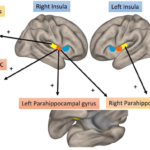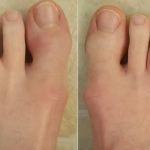Immune Mediators
From insult to clinical phenotype
The most remarkable evidence that unique cells are both necessary and sufficient in pathogenesis derive from the anecdotal—but compelling—observations that psoriatic disease can be (and has been) effectively cured in humans. In fact, several cases illustrated in the literature describe how unilateral, central and peripheral neurogenic disorders, such as stroke and post-poliomyelitis paralysis, spare the affected limb from psoriatic skin and joint inflammation, suggesting the need for neuronal signals to trigger local immune responses.25-27
The underlying mechanisms that can explain this brain-psoriatic axis are slowly emerging. For example, in an animal model of psoriasis it was found that psoriasiform rash was dependent on the interaction between a subset of sensory neurons and skin-resident dermal dendritic cells (DCs).28 Intriguingly, upon selective ablation of these nociceptors, these dermal DCs fail to produce IL-23 and the subsequent recruitment to the skin of IL-17-producing γδ T cells.
These findings suggest a scenario in which pain fibers integrate environmental signals to modulate local immune responses to a variety of microbial and pro-inflammatory stimuli in psoriatic disease, possibly explaining the Koebnerization phenomenon.29 This was also demonstrated in murine arthritis models, where knee denervation protected against joint inflammation, as well as in humans, where studies stimulating the vagus-nerve system showed inhibition of cytokine production and attenuation of disease severity in rheumatoid arthritis (RA).30,31
Functional brain magnetic resonance imaging has emerged as a novel tool to measure brain connectivity in inflammation. Its recent use in RA demonstrated that increased connectivity between areas implicated in self-referential mental activity (i.e., default mode network) and multimodal sensory processing (i.e., the insula cortex) was associated with increased RA disease activity and rates of centralized pain.32 Moreover, inflammation correlated with increased connectivity in brain regions involved in sensory input, memory and reward pathways.33
Whether or not these approaches will bring further insights and/or demonstrate therapeutic potential in PsA remains to be seen, but they provide proof-of-principle that the neuroimmune connection is of high relevance for modulating synovitis in psoriatic and related diseases. Notably, it has been demonstrated that the transferring of a whole new population of bone marrow-derived cells from a healthy donor to an affected histoidentical host or receiving an allogeneic hematopoietic stem cell transplantation can resolve both psoriasis and PsA, leading to drug-free remission for up to 20 years in some cases.34,35
Consequently, if replacing the entire set of immune cells can all but cure psoriatic disease, the question in the field has been one of specificity: Which particular cells (or group of cells) are responsible for disease pathogenesis?


